April 13, 2025 by Mark Tweedie
Golden Hour by Sophia Rosenthal - a review
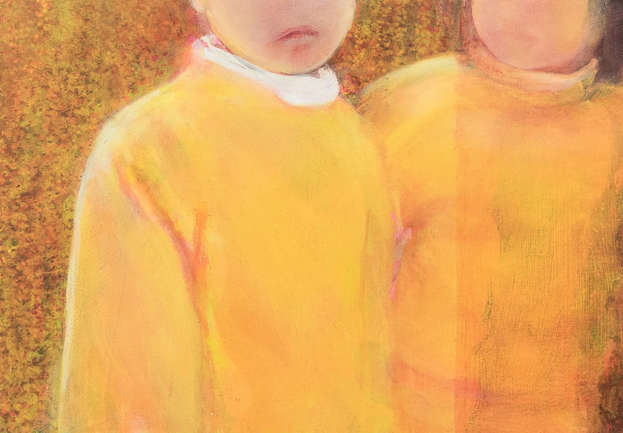
I recently had the good fortune to see an exhibition at the Standpoint Gallery in London by the talented painter Sophia Rosenthal. I started to write down some ideas which somehow over the course of a couple of days resulted in a full-blown review which I bound as a small book, the text of which is reproduced below. More of Sophia’s work can be seen at https://www.sophiaxrosenthal.com.
All images © Sophia Rosenthal.
Sophia Rosenthal’s recent residency at Standpoint Gallery in London has produced a thought-provoking and emotional body of eleven works. Using oil and acrylic on wood panel, aided with occasional monotype printing we gain a privileged view into not only her past, but by association and reflection, our own past with all its resonances and links with the present; we are offered a mixing up of glimpses and faint memories of childhood to stir into the more immediate emotions and perspectives which accompany us daily as adults.
This is not nostalgia, however, and to interpret it and the way subject is handled as such would be insensitive to the works’ undeniably modern and gently disruptive ambience. It would miss their power and attractiveness entirely. Whilst Sophia’s backward glances unapologetically delve into the warmth of the remembered past, her approach is far from cosy. With the exception of one sole work surprising the viewer with an ironic glance of an eye – and one fancies perhaps a cheeky wink of reassurance – there are no recognisable faces here. Half-faces, yes, hair-lines, yes, but nothing which crosses the boundary into portraiture.
One might initially feel deprived or confused by these paintings of people with nothing overtly individual or complete to give us solid ground. However, this lack of anchorage in a specific person brings a universality to each work. No viewer will feel like an outsider here; like myself they may never have owned a golden jumper as a child but they will almost certainly instantly substitute this with their own surrogate – the red shoes or the green hat, perhaps – and find themselves in the centre of the scene. Some art takes one hostage with its brash assumptions and symbols but here the mood is much gentler, the questioning it provokes is far more compassionate. I most definitely found myself being quietly seduced by the inclusive nature of the ambiguity.
Still, we are not let off the hook completely. Instead of our being allowed to start with a degree of certainty about what we are seeing, we are cast adrift to to make our own way, to draw our own threads through the body of work and ultimately to come to terms with what might be happening. And all the time we have our hands held calmly and reassuringly by the utter beauty of the colours and the deftness of the play of light and shadow. How can you really be disturbed by something so gorgeous to the eye! Sophia’s skill is to simultaneously challenge and sooth in such a seamless way that what might be hard work at the mercy of a lesser talent is a pleasurable and joyous exercise.
On the way home on the train, and indeed the following day as I write this, the atmosphere of this exhibition persisted. It seemed to me curious that this sensation should keep my mind back in the exhibition hall for such a time when the works were no longer before me until I realised the source of this pervasive feeling. The meaning of the show’s title helped get me there: Golden Hour.
The children in the images – and in my mind’s eye – are there under the loving watch of the parent at that time of day which anticipates or reflects on the joys of the day, at that time of day when the Sun makes everything magical with the enhanced warmth of its light. Although at first glance, the paintings depict children, in fact, as a body of work they generate an equivalent sense of that background glow of a day remembered by the guardian adult, the perfect day. This might be the adult remembering themselves as a child or the adult remembering a day with their own child. The persistent feeling I experienced was nothing less than a recurring loop of almost ancestral remembrance linking me with my own children, my own childhood, my parents and grandparents. It was something within me that Golden Hour brought back into the light.
The scope of what Sophia is dealing with in the show is expansive even though she chooses to treat it in a vignette-like way. it might be that this golden hour applies not just to a day but to our lives. Inevitably we will not be able to reflect on the the latter golden hour in this case, but do we not all cast our thoughts frequently back to the golden “hour” of our youth? That place where all things seemed different, where the world was moulded to our reality rather than as our experience as adults where we are impelled to adapt to the outer material world.
The title also tells more about the works’ collective undercurrent, manifested in swells of unspoken, bitter-sweet impressions. The show is golden in its richness of colour, intelligence, recollection; its hour is that brief period of childhood and the fleetingness of our revisiting it as we stand before these paintings, fully aware that in spite of seeing the past flash before us, it can never be recaptured. It successfully avoids melancholy, however, in constantly pulling the viewer back to the present (and its own joys and richness) with dashes of unexpected colour (the reflection of light in hair or grass); delicate shadows inviting curiosity and inspection (the shadow of one child changing the tone of its sibling’s identical jumper); compositions which pull us up and make us ask why it is that the ostensible subject of the painting is barely within its frame.
No treatment of memory and the past in our modern times can ignore the ubiquity of photography which traces, punctuates – and sometimes governs – the pattern of our lives. Sophia’s work draws heavily on photography both in material ways and in attitude. She works extensively from childhood photographs, frequently just clipping miniscule portions for use, invariably ignoring or cropping out the personally identifying elements. This provides her with a structure and reference to previous years on which is overlaid Golden Hour’s big strength: colour and texture. Here we have photo-journalism, albeit very personalised, with the added feeling that only the physical materiality of paint can imbue.
There is a real sense of looking at an album with this show. Even if one were unaware of the link with photography it would be plain that here we have a carefully-chosen series of snapshots from a life. They are presented without explanation but with simple titles to anchor them and magnify the significance of each of the works within the whole. Titling can sometimes be the most difficult aspect of making art! But Sophia makes this seem effortless, just in the way she conjures meaning from pigment which leaves a non-painter stunned that such things can be possible, the poetry of her titling is not mere artifice. The name given to each work demonstrates a depth of thought and feeling to get this right, in the same way that the brush strokes in the works themselves are judged and executed with a beautifully graceful touch.
Moreover, the titles add their own vital contribution to the whole rather than being superfluous and trite. Dimpled (By Lush and Searing Bright), for example, has distinct echoes of poet Gerard Manley Hopkins (“As tumbled over rim in roundy wells/Stones ring”). Sometimes, such as in this case, they are not easy, we are not given a simple answer to our inevitable questions about its meaning. This is, I think, intentional. It serves to hold us longer with some of the works which are perhaps more difficult to interpret, gives us a reminder that we need to spend a bit more time here to get what is going on. There is a playfulness – childish (as distinct from puerile) - between the paintings and their titles, too, relieving our over-serious adult approach and reminding us that we can just enjoy as well as analyse!
Golden Hour as a body of work, and indeed its constituents as individual works of art, is a triumph in so many ways. That it has been created in a few short weeks is quite breath-taking; there is an undeniable, understated confidence in every aspect of its conception and execution; it treats a universal theme with zest, compassion, consideration and intelligence; it is easy to enjoy but repays deeper thought about its subject and the way in which it works artistically; there is an exhilarating minimalism in its presentation which belies the broadness of its ambition; it is both serious and fun.
It is worthy of our time and our effort to interact with it and understand its meaning. It deserves to be seen.
This is pure poetry in paint.
The Works
Dimpled (By Lush and Searing Bright)
Oil and acrylic on wood panel 21 x 29.7 cm
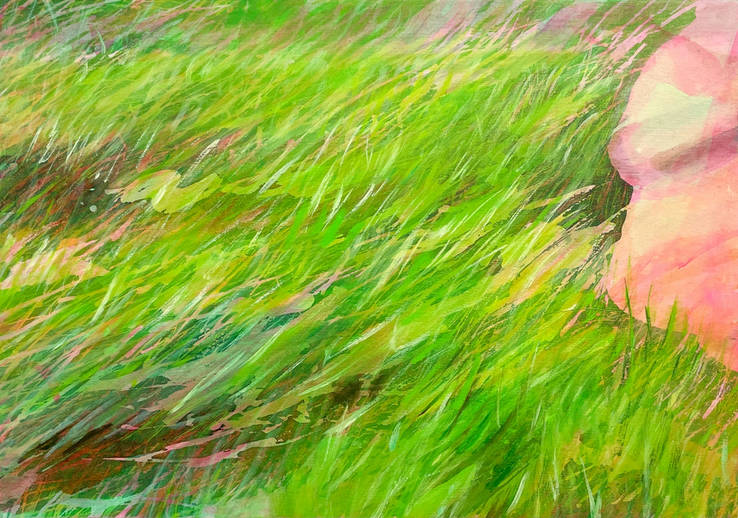
In one of the most enigmatic pieces here we are invited to ponder the visual descriptions for a temporal experience. There is a tension between the physicality of the title’s words, very much anchored in the senses, and the memory evoked by the image. What is dimpled, bright and lush? Looking closer we get a sense of a child on the grass revelling in the effects of light and water in the grass, fully aware of the magic of the scene but perhaps before he or she were able to articulate how wonderful the dazzling moment appeared. The grass is full of colour, shades and textures. It is seen by the painter’s eye, the one we all have as an infant before the rationality of the world takes us over, where in every blade of grass there is a universe of delight, where nothing is dull and everything is “lush and searing bright”.
Brief Apricity
Oil and acrylic on wood panel 21 x 29.7 cm

Unsurprisingly, this work was chosen as the poster for the show. Striking in both its use of colour and texture, it is the visual lead in to the show as a whole – the focus on childhood, its feeling of a snapshot, the lack of eyes (yes, dear viewer, you bring the eyes!) There is such drama in the moment here. The central figure faces the camera/artist directly though not with the grin often employed out of self-consciousness; the mouth is down-turned and without doubt something is happening. The child on the right, apparently heading rightwards out of the frame, looks questioningly at her sibling. However, there is no sense of danger, the ambience is more suggestive of a moment of realisation or reconciliation. The richness of this is underscored by the warmth and depth of the golden jumpers, the golden shadows and the gentle stipple of the backdrop. The quiet calm and dignity of the child shines out in the use of colour suggestive of evening; there is a gentle fatigue in the child’s shoulders and the day is done, the perfect day where everything is golden.
Again, Sophia makes the title work in tandem with the image. I imagine that, like me, most people would have had to look up the meaning of “apricity”, but how perfect this word is, a word which fell out of currency centuries ago! The warmth of sunlight in Winter, so unusual, so welcome and so short-lived, just like a memory, an emotion or a glance. A word steeped in times past but relevant to now.
Linger
Oil and acrylic on wood panel 21 x 15 cm
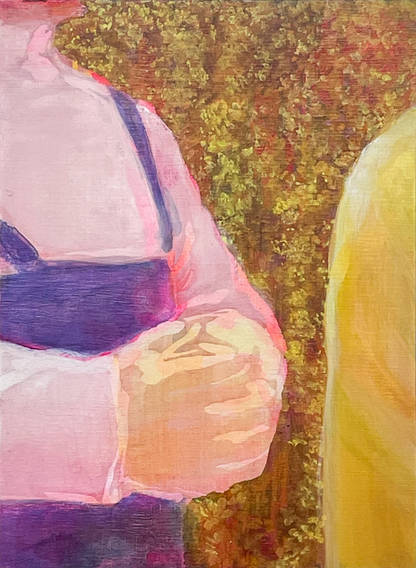
An evident adjunct to Brief Apricity, and hung alongside it in the show, Linger carries the moment further. The backdrop maintains the basic rhythm, the golden arm makes the link, but now we have a new figure, one who waits for an unknown reason. Are those hands in prayer? Or perhaps a symbol of steadfastness? Or even a stubborn outsider trying to break in to the day. Whatever the cause she has to linger, the pink sets this new child apart, quite distinct and separate from the golden children. The presence is not threatening but this is the dress and attitude of an outsider. The outcome we can only guess at but underlying the contrasting colours there seems to be a sense of a break in unity of colour, of height, of stance (of family even). Will the outsider continue to linger or will she be admitted? A tension has been introduced into the harmony of the apricity which has been briefer than we knew for reasons beyond simple weather.
A Faint Breeze
Oil and acrylic on wood panel 21 x 38.5 cm
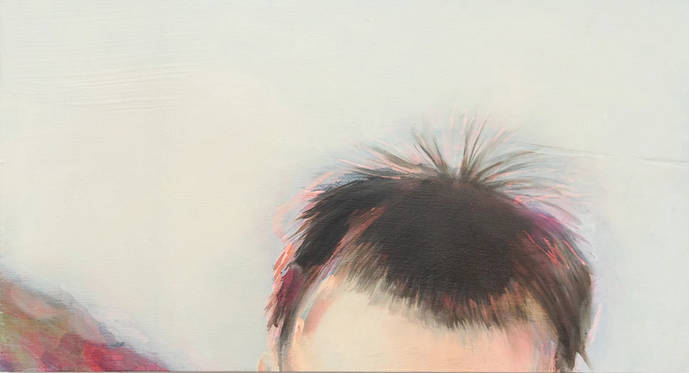
This is an ambitious work which takes risks – it is possible to paint the invisible? - and succeeds in a masterful way. The breeze of the title shows in the brush strokes with immense subtlety but just enough vigour to be seen. The hints of the hair being ruffled are accentuated by the shards of colourful light which burst from within it. All the time the individual elements hold together and anchor to one another: the infinitely subtle pinks and blues in the sky support the sparkling light in the child’s hair and skin and are bolstered by the stronger tones of the almost incidental - but absolutely vital - blurred element in the lower left providing the only solid part of the backdrop. We have wind embodied here and a unity of skin, sky and light. Words would struggle to adequately portray this fleeting moment but here in paint we have the whole in all its thrilling transience.
Behind Closed Eyelids
Oil and acrylic on wood 61 x 92 cm
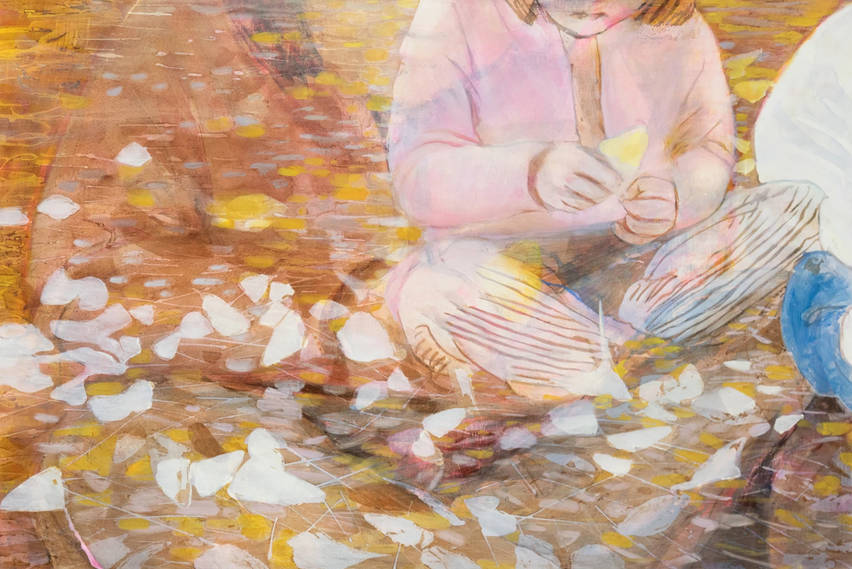
This larger work gives a much more expansive perspective than the more intimate, smaller ones. It is broader in field with an extra dimension of overlaid, half-seen detail. The reference to memory is more overt here, first in the title which conjures images of closing one’s eyes in order to recall, and then with translucency of layers reminiscent of the way in which memories mix past and present, large and small, insignificant and momentous. The leitmotif of golden light runs through the background and the pastel clothing recalls the wide, open skies in A Faint Breeze and Still Reeds Thinly Sway. The thoughtful, unsmiling mouth is here too continuing the undercurrent of understated dignity. Now we have another mood too, a slight wistfulness, provided by the fallen leaves, shattered shards of life, prescient of advancing age and the coming of Winter. The great enigma is the background layer in which I can see only an adult figure in a coat, a watchful, benevolent presence remembered for the strength and constancy it has woven into the lives of the children who can play untroubled in its shadow.
Soft Play
Oil and acrylic on wood panel 29.7 x 63.5 cm
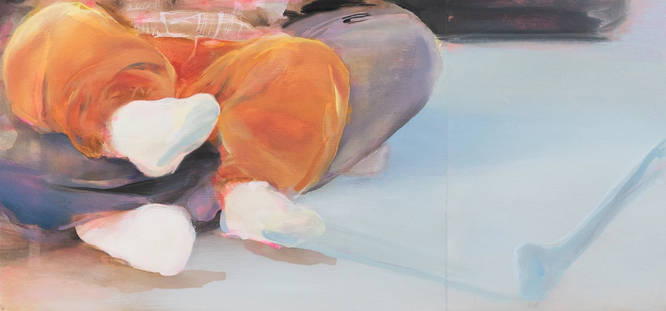
Softness abounds here: softness of light, of clothing, of mood, of sentiment. The underlying sense of care-giving – the child on the lap of another – is accentuated by this pervading feeling of easy, casual sharing. As usual we have no faces to guide us and have to rely on colour and texture. Complementary colours, oranges and blues, give the viewer confidence to know that all is fine in this tiny fragment of the past. It is almost as if we are being manipulated by the gorgeousness of the moment and the luxury of its recording. There can be little doubt that we are witnessing a warmth of shared experience that glows like the deep orange of the toddler’s clothing.
Peering Over Last Light
Oil and acrylic on wood panel 21 x 29.7 cm

The day is ending. The sun has set. The comfortable glow of yellows and reds has almost vanished to be replaced by blues and greys. Still, in common with the mood of this body of work, we see no regret, no anxiety, despite the shift in tone. The child’s fascination with the last light is full of excitement which we see expressed in the dynamic composition and its rush forwards to a new day to come. Although again we have no eyes depicted to direct us, we cannot help but assume that this ending of a day implies another equally fulfilling one to come and not wistfulness at the passing of the one just lived.
Flash
Oil and acrylic on wood panel 21 x 29.7 cm

The immediately striking element in this work is the eye. The only one in the whole body of work and as such an eye with immense significance. It contains a smile which works on more than one level. It is the smiling of the painted child, full of inquisitiveness and fun as if playing hide and seek. Simultaneously, it is the eye of the artist, encouraging the viewer and helping them with a small relief in the form of a welcome glance. We have been playing hide and seek until now and we have been granted a break. The colours have been muted too but not the energy of the work. The shine of the hair and the background lines lead us upwards and outwards; we know that soon we will be away again to continue to follow the thread of intrigue and imagination through the remaining works.
Still Reeds Thinly Sway
Oil and acrylic on monotype on wood panel 42 x 29.7 cm
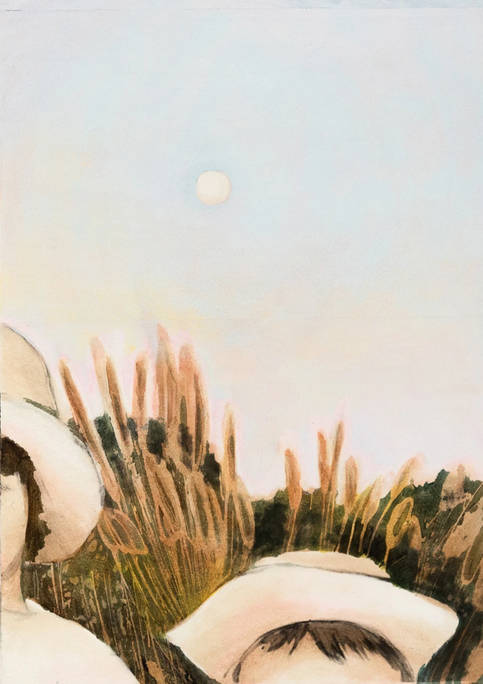
After the dynamic rush of colour and composition in the works so far we find a change of pace in this piece. There is a delicacy of mood and a calmness now. The children have stopped, the wind has dropped, the boldness and boisterousness of the world has sunk into brief rest and all we have is the gentle swaying of the reeds and the intricate, scarcely distinguishable play of pastels in the sky. We sense a wholeness in the distant full moon (or possibly a creatively dimmed sun) echoing the presence of the children in their summer hats, standing together in stillness and formality alongside the elegant reeds.
Golden Hour
Oil and acrylic on wood panel 61 x 92 cm

Golden Hour comes with an echo back to Behind Closed Eyelids and a realisation that this is the title piece of the whole body of work so we should pay some attention. Is this drawn from the very same photo? The leaves are piled almost identically, the trousers bear very similar stripes, the crossed legs and the clothing of the sibling just out of frame are surely the very same? One must ask the question why an artist would paint two large works with such a substantial overlap. This question unlocks what is going on. Behind Closed Eyelids is a much broader view whereas Golden Hour homes in close to what Sophia wants us to consider. The gold, the short hour, the focus of the child on the leaves which have increased in number since the first painting – this is almost an alternative dandelion clock, counting down the passage of time, punctuating the memories of the day. It finds foundation yet again in colour – the white leaves of Behind Closed Eyelids are now yellow; time has advanced and the memory and the focus have intensified; the broadness of the wider view boils itself down to very tiny movements, objects and thoughts. Therein lies the potency of memory, it is not narrative it is point-source illumination, it is quantum in its ability to leap years and decades without fading where a simple story would fall dog-eared and unread.
A Buried Roof
Oil and acrylic on monotype on wood panel 21 x 29.7 cm
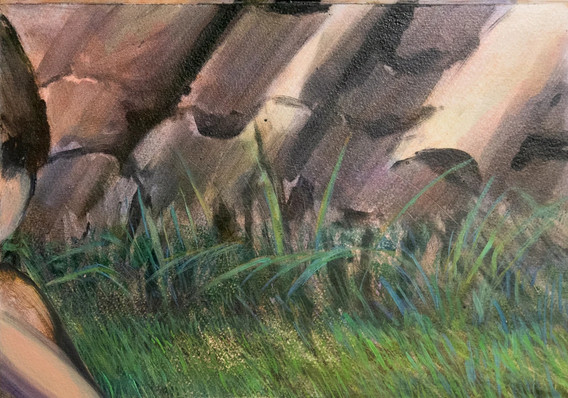
A Buried Roof is less accessible than the other works in the collection. Initially it is visually somewhat confusing. How can an inanimate roof take a place amongst such personal and human-centric themes such as soft play, basking in sunlight, playing with leaves? It is, I think, a metaphorical stake in the earth; the outside world is always present, it is sometimes hard to interpret, but at the same time it provides the backdrop to the more emotional events of life and is just as memorable for that. Of course, it too is subject to the flow and passage of time as we are shown here where the earth has risen – or the roof has dropped – so that both meet unexpectedly. The partial figure on the left is either looking intently, questioning the solidity or leaving everything behind, the angle of the arm suggesting haste.
Some images of the binding process can be seen at https://press.secretstill.uk/portfolio/books/golden-hour/.